Vintage Treasures: Big Planet by Jack Vance
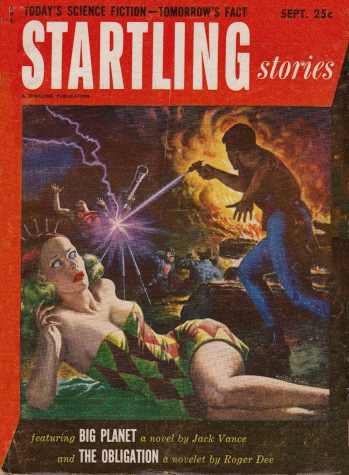 |
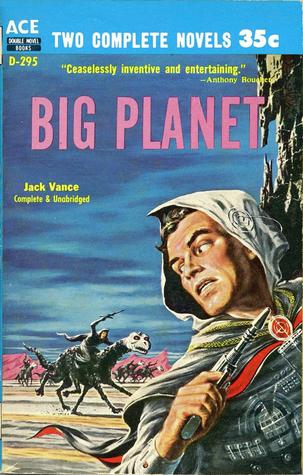 |
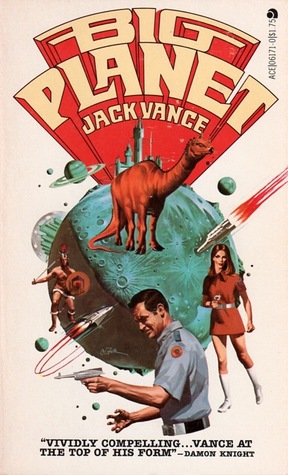 |
I’m embarrassed to admit that I became a Jack Vance fan only late in life. I blame a misspent youth.
I first discovered him through his short fiction — especially “The Dragon Masters” and “The Moon Moth,” two brilliantly imaginative tales of far-off worlds. But I was slow to discover his novels and I’ve spent the last few years trying to catch up.
The one I want to read next is Big Planet, his 1952 novel of a massive but technologically backwards world known simply as Big Planet, settled over the centuries by a host of criminals, malcontents, and outcasts from Earth. Claude Glystra is sent to Big Planet to investigate rumors of a dark plot against Earth, but his ship is sabotaged and crash-lands 40,000 miles from his destination. Glystra and his crewmates must undertake an impossible journey on foot across a dangerous landscape filled with aliens, human colonies isolated for centuries, and the treacherous agents of his enemies.
Big Planet was Vance’s first major SF novel, and it is one of the classic adventure fantasies of the 1950s. It has been reprinted over a dozen times. I have several different paperback editions — and they are, in fact, very different. All I have to do is figure out which one to read.
[Click on any of the images for bigger versions.]
Big Planet was first published in the September 1952 issue of Startling Stories (above left, with a typical pulp cover by Walter Popp). If pulp magazines of the 1950s are to be believed, men of the future will spend the majority of their time blowin’ stuff up, while women will spend it reclining in the foreground. Clearly, the original edition is a fine choice, except for one problem: I don’t have a copy.
Fortunately, I have multiple copies of the next major edition: the 1958 Ace Double (D-295; middle pic above, cover by Ed Emshwiller), where it was paired with Vance’s 1952 novel Slaves of the Klau. But there’s a problem with this one, too — it’s substantially cut. Magazine versions were usually expanded for later publication, but the reverse happened with Big Planet. It was published in hardcover by Avalon Books in 1957 in a substantially cut and edited version. It was that version that was reprinted in paperback by Ace.
Well, that’s disappointing. I’m still fond of the Ace paperback though, partly because it has one of the most evocative descriptions of the novel on the inside front cover, probably penned by Donald A. Wollheim:
Interplanetary Odyssey
The gigantic world known as Big Planet had become a wilderness of strange peoples and weird cultures as a result of having been the dumping ground for every crackpot and malcontent that ever emigrated from the Earth. Somewhere in its unmapped vastness a plot was being hatched to disturb the peace of the mother world’s civilization.
Claude Glystra was sent to Big Planet to foil that plot. But his spaceship crash-landed far from his objective — 40,000 wild and woolly miles from it. He and his companions would have to walk the distance — a trek that would have daunted a dozen Marco Polos — and at the same time fight off not only the wild beasts, the wilder natives, but the wily schemes of their foeman and his secret agent among them.
Big Planet is a terrific adventure, packed with the excitement, color, and new concepts which have gained it the unanimous applause of science-fiction readers everywhere.
The original text was finally restored for the 1978 Ace edition (above right; cover by Vincent Di Fate). This is the one to read. Fortunately, it’s still easy to find, and in fact I had a copy for years — until I mailed it to Howard Andrew Jones when he told me he was interested in reading it last year.
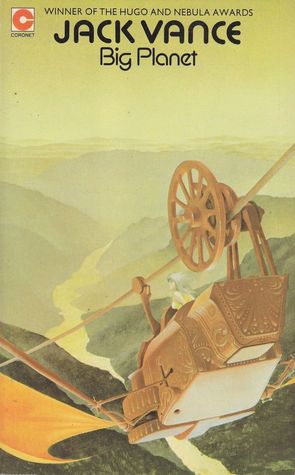 |
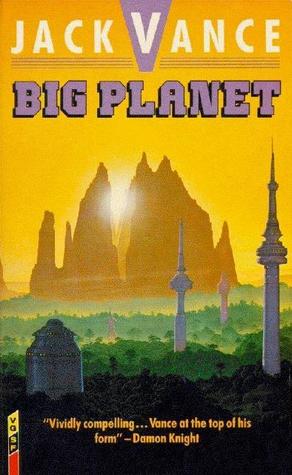 |
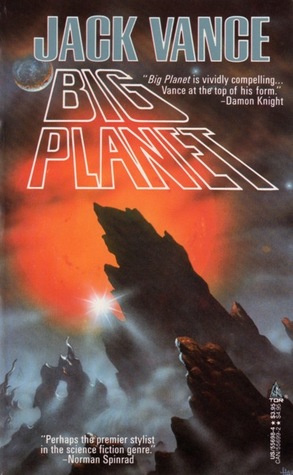 |
Well, let’s look at our other options. There are several handsome British editions, including the 1982 Coronet edition (above left; cover by Jim Burns). You guessed it: I don’t have a copy of that one. Ditto the 1989 VGSF/Gollancz paperback (above middle, cover by Brian Waugh.)
Fortunately, the book was reprinted again here in the US in 1989 by Tor (far right; cover by David Hardy.) Believe it or not, this one was a little trickier to find than the nearly 60-year-old Ace Double edition, but I eventually landed a copy. Hurrah! And if this turns out to be the edited version, believe me, I’m going to be cranky.
If you’re in the market for a copy of Big Planet yourself, I recommend the 2002 Gollancz SF Collectors’ Editions version, the most recent paperback edition I was able to verify exists (below left; cover by Jim Burns again). If you don’t mind an omnibus edition, Gollancz also reprinted the book in an SF Gateway Omnibus just last year, bundled with Vance’s The Blue World and The Dragon Masters and Other Stories (October 2013).
There are also easily available ebook editions from both Gateway/Orion and Spatterlight Press.
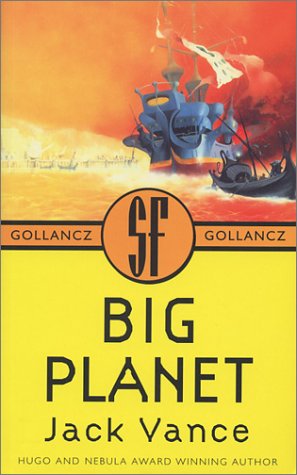 |
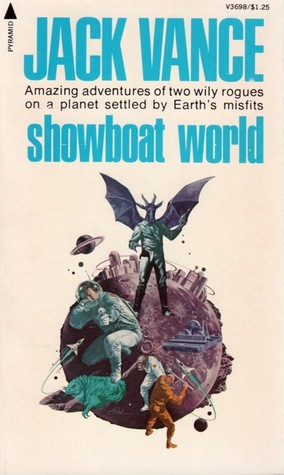 |
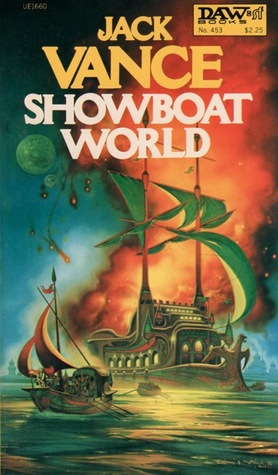 |
Big Planet was popular enough that Vance returned to the setting 23 years later with the standalone novel Showboat World, published in paperback from Pyramid in 1975 (above center, cover by Vincent di Fate). Showboat World had its own healthy publishing history, including a 1981 DAW reprint with a gorgeous David B. Mattingly cover (above right.)
Big Planet is a slender little book (my Ace paperback edition is scarcely 158 pages), which I think is part of its charm. I’m delighted to see Jack Vance’s novel remain in print for very nearly six decades and I expect it will return to print in many more handsome editions in the future. Keep an eye out for it.
We’ve covered several Ace Doubles recently, including:
ATTA/ The Brain-Stealers by by Francis Rufus Bellamy and Murray Leinster
The Ship from Atlantis/ The Stolen Sun by H. Warner Munn and Emil Petaja
Vulcan’s Hammer / The Skynappers by Philip K. Dick and John Brunner
The Ship That Sailed the Time Stream by G.C. Edmondson
Bow Down to Nul / The Dark Destroyers by Brian W. Aldiss and Manly Wade Wellman
Gateway to Elsewhere / The Weapon Shops of Isher by Murray Leinster and A. E. van Vogt
The Cosmic Puppets / Sargasso of Space by Philip K. Dick and Andre Norton
The Beast Master / Star Hunter by Andre Norton
Big Planet by Jack Vance
City Under the Sea by Kenneth Bulmer
The Forgotten Planet (Planets of Adventure) by Murray Leinster
Six Worlds Yonder / The Space Willies by Eric Frank Russell
Sentinels of Space / The Ultimate Invader by Eric Frank Russell and Donald Wollheim
Ring Around the Sun/ Cosmic Manhunt by Clifford D. Simak and L. Sprague de Camp
The Trouble With Tycho/ Bring Back Yesterday by Clifford D. Simak and A. Bertram Chandler
The Last Planet (Star Rangers) by Andre Norton
A Touch of Infinity/ The Man With Nine Lives by Harlan Ellison
Kirkus Looks at Donald A. Wollheim and the Ace Double
Tales of Outer Space/ Adventures in the Far Future edited by Donald A. Wollheim
The Pirates of Zan by Murray Leinster
See all of our recent Vintage Treasures here.
I have a copy of the Ace Double version and indeed I reviewed it here:
https://www.sff.net/people/richard.horton/aced73.htm
I suspected it was cut but I don’t have a copy of that issue of STARTLING STORIES, alas! (I do have the SPACE STORIES issue that included the original version of SLAVES OF THE KLAU, though)
—
Rich
You gave me a copy that inspired my own review and my thoughts on how early Vance dealt with the role of women in his books:
http://www.howardandrewjones.com/writing/vance-robert-e-howard-and-the-role-of-women
Thanks for the link, Rich. And that’s a fine, concise review (with minimum spoilers, which I appreciated!)
One mystery that remains is WHY Avalon Books cut the original version, and WHAT they cut. Was it simply edited for length? For content? I’ve never found anything in a Vance story that I would rate about PG, but then again I’m not an American publisher in 1957.
Another fine review, Howard… and I think your comments on Vance and his women characters are spot on. I haven’t read enough yet know if he improved in his later novels.
I’m glad you put that copy to good use. And I hope I sent you the complete Ace edition, rather than the edited one!
I would say a certain hint of misogynism stayed with Vance throughout his career, though not in every novel. But often he would feature beautiful but cold or perhaps treacherous women characters, who might get their comeuppance along the way. Of course sometimes he featured treacherous male characters who eventually got their comeuppance.
I make some note in my review linked above, particularly in my review of SLAVES OF THE KLAU, of that aspect of his work — especially in the way Komeitk Lelianr from that book can be regarded almost as a prototype of Vance women characters going forward. I think the major women characters in the fairly late (and quite good) ALASTOR books make a good study in this regard, especially their treatment in the variations on the game “hussade”, which occurs in different forms in each of the three novels.
“Clearly, the original edition is a fine choice, except for one problem: I don’t have a copy.”
I might…hee, hee, hee. Need to remember to check when I get home.
And I particularly like the di Fate covers. They remind me of the 70s, when I first became aware of sf and space art. I even had a set of folders for school that were a series of di Fate paintings.
Hey, Hugo Award Winning Editor Rich Horton, I concur with your assessment. Vance did get better with his depictions of female characters with agency, but the best I’ve yet seen him do was in Lyonesse, a definite improvement but still usually renders them as in need of rescue, regardless of their improved characterization.
I still have Alastor and its sequels unread, and plan to dip into them the next time I’m in a Vance mood.
John, the copy of Big Planet you sent me has the same cover as the ACE double, but it’s a single! No Klau, slaves are otherwise, are featured within this novel. So I wonder — is this one edited down, or complete? Who can say?
I think the cuts were made for both content and length. Some sentences were shortened at the beginning of the book, which makes the prose duller and less interesting. A brief scene where Glystra sees what goes on inside a dwelling was cut, presumably for horrific content, though everything is implied rather than stated outright. Also, a plot point was rendered absurd in what is clearly censorship. The savage band that pursues our heroes at one point are viewed with terror because (Ace version) they are slavers; but previously two local girls expressed a willingness to become slaves to the Earthmen. The nomads are in fact feared because they are cannibals, and the local girls want to be enslaved because if the herd they keep does not feed the tribe through the winter, the girls themselves will be eaten.
By all means, read the Tor version. This is far from Vance’s best novel, but it is much better appreciated in the original text.
If you want to check out the differences in-depth, check out this article. http://axoaxo.com/jackvance/jvbbs/cosmo-bp-scissors-rev.doc
> I think the major women characters in the fairly late (and quite good) ALASTOR books make a good study in this regard,
> especially their treatment in the variations on the game “hussade”, which occurs in different forms in each of
> the three novels.
Rich,
It’s odd, but I don’t hear that much about later Vance. Certainly my interest has been in the novels I hear mentioned time and again (The Demon Princes, the four Planet of Adventure books, The Five Gold Bands, To Live Forever, The Languages of Pao, The Blue World…), which I’ve noted chiefly date to the 60s and 70s.
Anyway, glad to hear that the later Vance is also worth investigating! Although at the rate I’m going, it’ll take me a while to get to it…
> John, the copy of Big Planet you sent me has the same cover as the ACE double, but it’s a single! No Klau, slaves
> are otherwise, are featured within this novel. So I wonder — is this one edited down, or complete? Who can say?
Howard,
Well, I can. Looks like I sent you 1967 the Ace reprint edition, buddy. Which was the edited version. Sorry about that.
Which means… I still have the 1978 di Fate edition. Somewhere. Probably. Wonder if I can find it…
> By all means, read the Tor version. This is far from Vance’s best novel, but it is much better appreciated in the original text.
Yves,
Great to hear from you! And thanks for the capsule summary of the edits. Sounds like the 1978 (and later) editions are the ones to have. 🙂
> If you want to check out the differences in-depth, check out this article…
Aaron,
Wow! That’s a fabulous link… thanks for sharing it! Here’s a fascinating tidbit from the opening.
+++++++++++
“Most of you, dear Readers, are under the impression that you have read “Big Planet”, a novel written by Jack Vance, as published by ACE in 1957. Well, I have some news for you… First the bad news: you’ve been had! What you have read should have been entitled “Small to Medium-Sized Planet”: a novel remotely inspired by an original* text written by Jack Vance, as published in the magazine Startling Stories, Sept. 1952. The good news is that you will have “Full Planet” in the VIE edition, in all its vivid details and content… If you’re already one of the happy owners of the Underwood-Miller 1978 edition, you know what I mean. If you’re not, I hope this article will give you a fair idea of the nature and extent of the editorial mayhem perpetrated by the ACE Editor.
<<* Well, not quite the original… In fact, we’ve lost what would have indeed been “Gigantic Planet”. Here’s the story behind the Big Planet Manuscript, as told by Norma in a mail: “The one thing I remember is that the original MS was very long. Jack let a local well-known editor, one Anthony Boucher, read it. After a couple of months on tenterhooks, he returned the MS to Jack with the advice that it was too long and would never sell at that length. Jack was greatly disappointed. He went to work and cut possibly 200,000 words. The discarded pages were used for first drafts which were destroyed after being transcribed. The MS stayed with his then agent, Scott Meredith, until it sold two or three years later to Startling Stories.”>>
+++++++++++
‘VIE edition…” presumably this is the Vance Integral Edition, published in hardcover in 2002 (http://www.isfdb.org/cgi-bin/pl.cgi?262847).
According to ISFDB, the Underwood-Miller version he talks about restores the STARTLING STORIES text; I assume it uses the same text as the restored Ace paperback that same year.
Do you know who wrote this doc?
And the VIE edition should also be the version of Big Planet available electronically from Spatterlight.
Which means I should probably reread that one sooner rather than later.
John — Vance remained excellent right until the end of his career — I suppose one can find a certain diminution of energy in his last two novels (PORTS OF CALL and LURULU) but the novel immediately prior, NIGHT LAMP, is one of his better novels.
The late SF trilogy (CADWAL CHRONICLES, beginning with ARAMINTA STATION) and Fantasy Trilogy (beginning with LYONESSE) are both highly regarded but much to my guilt I haven’t read them. From the ’70s I’d particularly recommend the ALASTOR trilogy (trilogy by courtesy, the books are not related by plot, only loosely by setting) and MASKE: THAERY, and of course EMPHYRIO (1969) is particularly good.
Love how it says ‘complete and unabridged’ on the ace when it’s, uh, apparently not.
My version is the same one Howard read. Looks like I need to hunt a full version as well.
The white ‘busy planet’ covers for both are hilarious — Showboat World in particular is like a collage of things that have nothing to do with the book — demons, apes in spacesuits, iguanas — what the hell, just throw it in.
[…] first an Ace Double under the title Slaves of the Klau (paired with Vance’s popular novel Big Planet), and in hardcover by Underwood Miller in 1982 (not […]
[…] as testament to just how enduring they were — including books like Jack Vance’s Big Planet and Andre Norton’s The Beast Master, both of which have been reprinted over a dozen times […]
Bit of a late post from me. I too discovered Vance via The Dragon Riders, years back but since then I can’t say I have read much of his work. I keep meaning to get to it. having just completed the Big Planet/Slaves of the Klau ace double must say I really enjoyed both of the “full novels” ha ha.